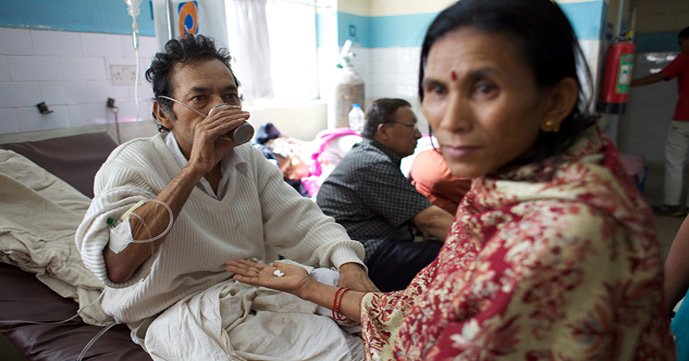This is bad.
Tuberculosis (TB) has been a global pandemic for over a decade now; we already knew it was a serious global health problem. It’s worse, though, than we knew. The new World Health Organization (WHO) global TB report finds that TB is actually worse than we realized.
The global data on TB has been under-reporting tuberculosis deaths. For example, in 2014, 140,000 children were recorded as dying of TB. In 2015, it was 210,000 children. We didn’t seen a sudden jump in sick children – we got better at identifying TB deaths. The same is true of overall TB deaths – the number went up from 1.5 million in 2014 to 1.8 million in 2015.

Tuberculosis is a bacterial disease that is fatal if untreated. Most TB infections can be cured with a combination of antibiotics; this is known as susceptible TB. However, there are more dangerous forms of TB. Multi-drug resistant TB (MDR-TB) is infections with bacteria that are resistant to antibiotics. It occurs when susceptible TB is treated with the wrong drug regimen, or when a patients is infected directly by someone who already has multi-drub resistant TB. MDR-TB can also be cured, with a more complex regimen of expensive drugs that have serious side effects like deafness. A few cases of TB are extensively drug resistant (XDR-TB); these are very difficult and very expensive to cure, requiring drugs that can cause permanent harm to patients. Most patients die of XDR-TB before they can be cured.
The new global TB report from WHO is a snapshot of the global TB pandemic. While it contains some very bad news such the increased number of TB deaths, it does have some bright spots. For example, both the new of TB deaths and the number of new cases of TB are falling in India, which is home to one of the most severe TB epidemics. And the global TB response saved three million lives in 2015.
Most of the report is devoted to the data on TB and its treatment, but this is also the report that defines the language and strategy that WHO will use with regard to the global TB epidemic. So while the report presents the global data on TB, it also discusses how that data is collected, categorized, and used for decision-making. The entire report is couched in the language of the sustainable development goals, framing it as a new era of global TB monitoring.
The report states that “in 2015, there were an estimated 10.4 million new TB cases worldwide, of which 5.9 million (56%) were among men, 3.5 million (34%) among women and 1.0 million (10%) among children. People living with HIV accounted for 1.2 million (11%) of all new TB cases.” Of these new cases of TB, 60% came from just six countries: India, Indonesia, China, Nigeria, Pakistan and South Africa. China, India and Indonesia alone accounted for 45% of global cases in 2015 – 61% of estimated new TB cases were in Asia.
The numbers on HIV are particularly grim. HIV/TB co-infection makes it more difficult to treat both HIV and TB, and mortality rates are much higher for people with both diseases than with either disease on its own. The proportion of TB cases co-infected with HIV are highest in the WHO Africa region, and in Southern African are as high as 50%.
Globally, both the absolute number of TB deaths and the TB incidence rate have fallen since 2000 – if you exclude the HIV co-infected cases from the data. While this is good, it’s not good enough. The global rate of decline in the TB incidence rate was only 1.5% from 2014 to 2015. TB remains one of the top 10 causes of death worldwide. In 2015, it caused more deaths than HIV.
India has the highest TB disease burden in the world. The report includes higher number for India in both 2015 and in the past, based on examining historical TB data and identifying under-reporting. As the report authors put it, “This report includes estimates for India that have been revised substantially upwards compared with those published in 2011–2015, following accumulating evidence that the TB disease burden in India is higher than was estimated at that time.” India’s large population and serious TB burden means that changes to India’s numbers directly affect global numbers as well.
Overall, this report is a warning. We’re getting better at the data part of TB. Identifying cases and reporting them to national and international authorities. We’re also getting better at diagnosis different kinds of TB – susceptible, MDR and XDR TB and tracking their epidemiology. There are a host of new diagnostic and data tools available.
Despite these tools, we’re not getting better at actually preventing, treating and curing TB. One example – of the estimated 580,000 people in 2015 newly eligible for MDR-TB treatment, only 20% of them were actually enrolled in treatment. These are patients for whom drugs are available, but failing to get those drugs. The TB incidence rate is falling more slowly now than it did in the early part of the century. If we’re going to meet global TB targets and the Sustainable Development goals, we need TB incidence to fall by 4-5% a year, not stall at a 1.5% reduction.

What the Report Doesn’t Say
The WHO uses language of efficiency and effectiveness, but it doesn’t mention shame. Not getting children and people living with HIV the TB treatment they need is a failure of governance and moral responsibility to our most vulnerable citizens. Letting people with MDR-TB go without access to lifesaving care is shameful and there is something wrong with a world that lets it happen.
One Sentence Takeaway
We’re in the middle of a dangerous TB pandemic and we’re not doing enough to stop it.
